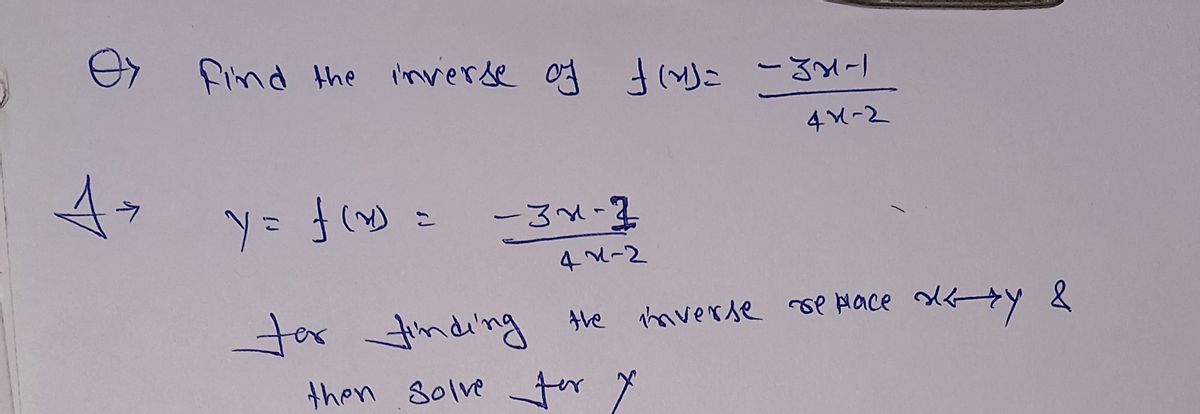Calculus: Early Transcendentals
8th Edition
ISBN:9781285741550
Author:James Stewart
Publisher:James Stewart
Chapter1: Functions And Models
Section: Chapter Questions
Problem 1RCC: (a) What is a function? What are its domain and range? (b) What is the graph of a function? (c) How...
Related questions
Question
![**Problem:** Find the inverse of the function \( f(x) = \frac{-3x - 1}{4x - 2} \).
**Solution:**
To find the inverse of a function, we essentially want to solve for \( x \) in terms of \( y \) and then swap \( x \) and \( y \).
1. Start with the equation for the function:
\[
y = \frac{-3x - 1}{4x - 2}
\]
2. Swap \( y \) and \( x \):
\[
x = \frac{-3y - 1}{4y - 2}
\]
3. Multiply both sides by \( (4y - 2) \) to eliminate the denominator:
\[
x(4y - 2) = -3y - 1
\]
4. Distribute \( x \):
\[
4xy - 2x = -3y - 1
\]
5. Rearrange the terms to gather all terms involving \( y \) on one side:
\[
4xy + 3y = 2x - 1
\]
6. Factor out \( y \) on the left side:
\[
y(4x + 3) = 2x - 1
\]
7. Solve for \( y \):
\[
y = \frac{2x - 1}{4x + 3}
\]
Therefore, the inverse function is:
\[
f^{-1}(x) = \frac{2x - 1}{4x + 3}
\]](/v2/_next/image?url=https%3A%2F%2Fcontent.bartleby.com%2Fqna-images%2Fquestion%2F2bb63943-7839-43c1-b3a8-054c60027bd4%2Fa75f8e0b-fa91-4d6b-aa37-1d05ee65b9f8%2Fymv1s9b_processed.jpeg&w=3840&q=75)
Transcribed Image Text:**Problem:** Find the inverse of the function \( f(x) = \frac{-3x - 1}{4x - 2} \).
**Solution:**
To find the inverse of a function, we essentially want to solve for \( x \) in terms of \( y \) and then swap \( x \) and \( y \).
1. Start with the equation for the function:
\[
y = \frac{-3x - 1}{4x - 2}
\]
2. Swap \( y \) and \( x \):
\[
x = \frac{-3y - 1}{4y - 2}
\]
3. Multiply both sides by \( (4y - 2) \) to eliminate the denominator:
\[
x(4y - 2) = -3y - 1
\]
4. Distribute \( x \):
\[
4xy - 2x = -3y - 1
\]
5. Rearrange the terms to gather all terms involving \( y \) on one side:
\[
4xy + 3y = 2x - 1
\]
6. Factor out \( y \) on the left side:
\[
y(4x + 3) = 2x - 1
\]
7. Solve for \( y \):
\[
y = \frac{2x - 1}{4x + 3}
\]
Therefore, the inverse function is:
\[
f^{-1}(x) = \frac{2x - 1}{4x + 3}
\]

Transcribed Image Text:Given that \( f(x) = 9x + 5 \) and \( g(x) = 3 - x^2 \), calculate:
(a) \( f(g(0)) = \_\_\_\_\_\_\_\_\_\_ \)
(b) \( g(f(0)) = \_\_\_\_\_\_\_\_\_\_ \)
Expert Solution
Step 1

Step by step
Solved in 3 steps with 2 images

Recommended textbooks for you

Calculus: Early Transcendentals
Calculus
ISBN:
9781285741550
Author:
James Stewart
Publisher:
Cengage Learning

Thomas' Calculus (14th Edition)
Calculus
ISBN:
9780134438986
Author:
Joel R. Hass, Christopher E. Heil, Maurice D. Weir
Publisher:
PEARSON

Calculus: Early Transcendentals (3rd Edition)
Calculus
ISBN:
9780134763644
Author:
William L. Briggs, Lyle Cochran, Bernard Gillett, Eric Schulz
Publisher:
PEARSON

Calculus: Early Transcendentals
Calculus
ISBN:
9781285741550
Author:
James Stewart
Publisher:
Cengage Learning

Thomas' Calculus (14th Edition)
Calculus
ISBN:
9780134438986
Author:
Joel R. Hass, Christopher E. Heil, Maurice D. Weir
Publisher:
PEARSON

Calculus: Early Transcendentals (3rd Edition)
Calculus
ISBN:
9780134763644
Author:
William L. Briggs, Lyle Cochran, Bernard Gillett, Eric Schulz
Publisher:
PEARSON

Calculus: Early Transcendentals
Calculus
ISBN:
9781319050740
Author:
Jon Rogawski, Colin Adams, Robert Franzosa
Publisher:
W. H. Freeman


Calculus: Early Transcendental Functions
Calculus
ISBN:
9781337552516
Author:
Ron Larson, Bruce H. Edwards
Publisher:
Cengage Learning